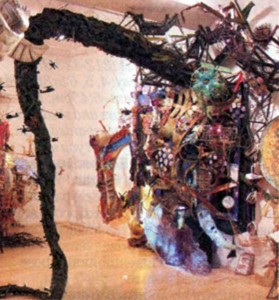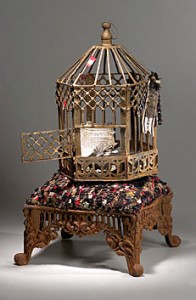For ‘Time Out New York’ Magazine

Jesse Bercowetz and Projects (a collaborative with Carrie Dashow) felt compromised by restraint. Judging by the riot of knockabout sculptures assembled from junk crowding “Things Got Legs” at Derek Eller Gallery, the pair seems determined not to make the same mistake twice. From the spinning head located inside the front door to the flashing lights of a dungeon-like installation in the back room, a carnival atmosphere prevails. But at times, a lack of focus threatens the potential punch.
The show’s energy and disorder stem from the same source: the artists’ enthusiasm for conspiracy theories and folktales, with many pieces confusingly alluding to several at once. The book-laden sculpture “Library” includes an extensive cache of audiotaped interviews with writers on topics like non-Al Qaeda 9/11 plots, secret government experiments and ESP. Across the room, “Can Jet Fuel Melt Steel?,” a rickety model of the WTC towers, constructed from shish kebob skewers and topped with a bowling ball, seems to mock a theory that many of those authors take very seriously.
Bercowetz and Bua’s uncritical approach sometimes backfires. In the rear gallery, an altar festooned with black fabric and lanterns suggests Halloween-party décor more than its purported subjects, child abuse and murder. But questioning the line between truth and fiction – as most of these works do – relates more than a little to the endless spin of our own political climate, giving this show a relevance that insouciance doesn’t diminish.
